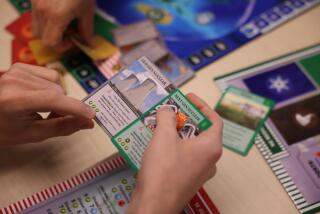Playing God Via Computer Science
- Share via
“SimEarth” was the name on the educational computer program Kathy Hayden--a teacher at L. R. Green Elementary School in Escondido--had brought home to study before using it in a fourth-grade class.
“It lets the kids create their own planet and be responsible for it,” Hayden said.
Her daughter, Jennifer, a senior at Poway High School, decided it was a heady experience to simulate on a color monitor what would happen if the temperature of the Earth were to rise a certain number of degrees. “I feel like God. I’m creating life,” she said.
SimEarth is cousin to SimCity, a program that allows the user to control and see the consequences of variables such as traffic flow and tax revenue.
This and other video-assisted environmental studies are taking hold in North County. Since last fall, whirring video disks and humming computer drives have been helping students from kindergarten to junior college conduct experiments and do research in various Earth sciences--biology, botany, geography, meteorology. Most programs come in Spanish and English.
“Kids are much more comfortable with video disks and computers than their teachers,” said Bill Simpson, a curriculum specialist with Escondido Unified School District.
But adults, including parents and teachers, are getting on the bandwagon. Introduction throughout North County of “video machines”--whether linked to a computer or videodisc or the new digital video compact disc players--is proceeding rapidly at schools from Oceanside to Del Mar.
At Glenville Middle School in Solana Beach, teacher David Mackintosh’s class is using video to design underwater cities and make sure they are capable of sustaining life. At Skyline School in the same district, fourth-graders operated a realistic weather station via the National Geographic Society’s computer network, which linked them with faraway reporting stations, including an elementary school in Moscow.
Bill Simpson and the other North County teachers using this technology are part of a group called CUE, or Computer Using Educators. He’s the San Diego County chapter’s membership secretary and North County’s unofficial information source on educational video machines, as he calls them. Weekend after next, he and his fellow CUE members are going to Palm Springs to see the latest “interactive video.”
Some of the excitement about these products comes from the statewide introduction into Texas schools last fall of a computer-based science curriculum titled “Windows on Science,” a step that could eliminate the use of books. El Paso and some other school districts have gone the whole way. Others are using regular books only as supplements.
This month, the California Department of Education began considering the adoption of several interactive video programs, among them “Windows on Science,” according to its producer, Optical Data Corp. of Warren, N.J. The program is already in use with regular science books in several North County schools.
Jostens Educational Corp., based in Mira Mesa, is a leading producer of interactive science software.
Here’s what’s on the screen in one of that company’s ecology lessons for middle-schoolers:
At the beach, students notice that marine organisms living on a rock grow in regular bands. Using visuals in the computer data base, they can simulate the growth of barnacles and snails on empty rocks and rocks already occupied by other barnacles. They also measure tide flow to determine the average time each area of the rock is immersed daily. Then they discover that limits on habitats in the intertidal zone are determined by factors such as dryness, predators and competition for space.
The lesson is not unlike the environmental issues involved in the traffic experiments in SimCity and in Jennifer Hayden’s video-aided discovery of the dangers of global warming.
The experience is a productive one for the students, according to Simpson, the Escondido curriculum specialist. “The children are really involved. They’re visual learners. They work in small groups, helping each other.”
Roy Beven, a science product developer at Jostens, sees more innovations to come.
“The way we teach science is really going to change,” he said. “It’s not going to be biology or botany anymore. The kids want more hands-on so they can develop their theory.”
For North County Computer Using Educators membership or information on the May 7-8 CUE state meeting and program show in Palm Springs, call Bill Simpson at 432-2187.
More to Read
Sign up for Essential California
The most important California stories and recommendations in your inbox every morning.
You may occasionally receive promotional content from the Los Angeles Times.













